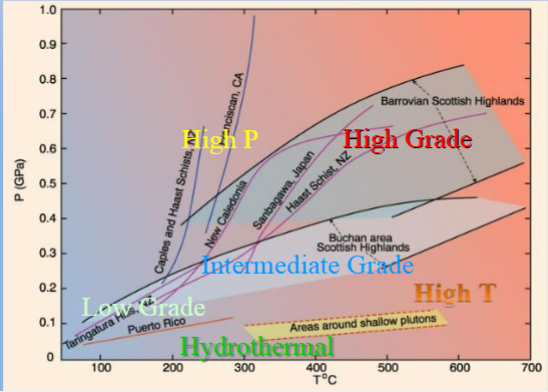Intro to Metamorphic Rocks
1/40
Earn XP
Description and Tags
Name | Mastery | Learn | Test | Matching | Spaced |
|---|
No study sessions yet.
41 Terms
IUGS-SCMR definition of metamorphism
Metamorphism is a subsolidus process leading to changes in mineralogy and/or texture (for example grain size) and often in chemical composition in a rock. These changes are due to physical and/or chemical conditions that differ from those normally occurring at the surface (weathering) and in zones of “alteration”, cementation and diagenesis just below the surface
In some high P-T environments that may coexist with and promote partial melting
Different Metamorphic Rocks (and their mineral components) are formed as a result of their formation
P- Pressure (depth)
T- Temperature (geothermal gradient or orogenic heat)
X- Composition (protolith)
and
Pf or X fluid- Geochemically active fluids (metasomatism)
The Limits of Metamorphism
Low-temperature limit grades into diagenesis
Processes are indistinguishable
Metamorphism begins in the range of 100-150C for the more unstable types of protolith
Marked by the formation of minerals such as zeolites group (laumontite, analcime, heulandite) caroholite, paragonite, prehnite, pumpellyite, lawsonite, glauciphase or stilpnomelane
Some zeolites are considered diagenetic and others metamorphic - pretty arbitrary
Metamorphic Agents and Changes: Temperature
Temperature: typically the most important factor in metamorphism
Continental geotherms are much lower than oceanic
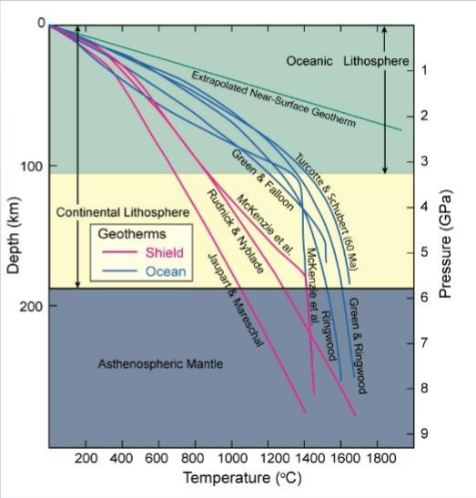
Increasing temperature has several effects
Promotes recrystallization → increased grain size
Larger surface/volume ratio of a mineral → lower stability
Fine aggregates coalesce to larger grains
Especially for fine-grained and unstable materials in a static environment (shear stresses often reduce grain size)
Drive reactions (endothermic - require heat)
Overcomes kinetic barriers (disequilibrium)
increased diffusion rates (fluids help)
May also initiate new mineral formation
Neocrystallization
Metamorphic Agents and Changes: Pressure
Pressure
Lithostatic = equal stress, confining pressure
Pressure increase about 1 GPa or 10 kb = 33km
Generally “burial” or “confining” pressure
Differential or deviatoric - unequal stress directions
Create foliation and lineations
Typically due to some tectonic forces- dynamic rather than state deformation and metamorphism
We expect metamorphic rocks to reflect the normal geothermal gradient dT/dP but:
“Normal” geothermal gradients perturbed in several ways, most commonly:
High T/P geotherms in areas of plutonic activity or rifting (e.g MOR)
High T/P from asthenosphere upwelling from subduction or delamination
Low T/P geotherms in subduction zones
Metamorphic Agents and Changes: Fluids
Evidence for the existence of a metamorphic fluid:
• Fluid inclusions
• Fluids are required for hydrous or carbonate phases
• Volatile-involving reactions occur at temperatures and pressures that require finite fluid pressures
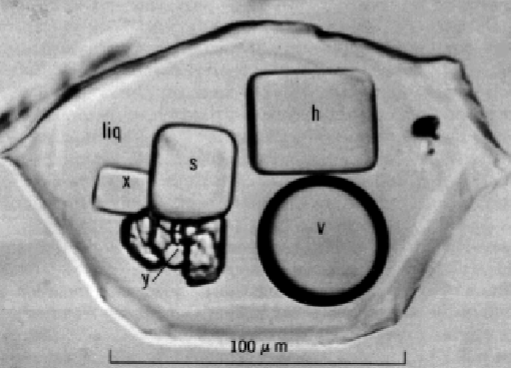

Metamorphic grade
Metamorphic grade: a general term reflecting increase in degree of metamorphism without specifying the exact relationship between temperature and pressure
High T/P paths (low P) favor the formation of low-density metamorphic minerals as temperature rises; Low T/P paths (High P) favor denser materials

Mineralogy not only depends on T and P But also Types of Protolith (original rock type)
Types of Protolith (original rock type)
Lump the common types of sedimentary and igneous rocks into six chemically based-groups
Ultramafic -very high Mg, Fe, Ni, Cr
Mafic- high Fe, Mg, and Ca
Shales (pelitic) - high Al, K, SI
Carbonates - high Ca, Mg, CO2
Quartz - nearly pure SIO2
Quartzo-feldspathic - high Si, Na, K, Al
Types of Protolith (original rock type): Different approaches to classification, 1. Based on principal process or agen
1. Based on principal process or agent
Dynamic Metamorphism (subduction or faulting- Hi P- deviatoric stress is dominant and deformation + recrystallization is the main process)
Thermal Metamorphism (igneous intrusion- Hi T in a near-static field)
Dynamo-thermal Metamorphism (regional or orogenic - range of T and P)
Hydrothermal (fluid assisted - MOR)
Types of Protolith (original rock type): Different approaches to classification, 2. Based on geologic/tectonic setting
2. Based on geologic/tectonic setting
Contact metamorphism
regional metamorphism
Orogenic metamorphism
Subduction Zone - paired metamorphic belts
Both high T/P and low T/P
Burial Metamorphism
Hydrothermal Metamorphism- +MOR type
Fault-Zone metamorphism - dynamic (subduction?)
Impact or shock metamorphism (meteorite)
Environments of metamorphism in the context of plate tectonics:
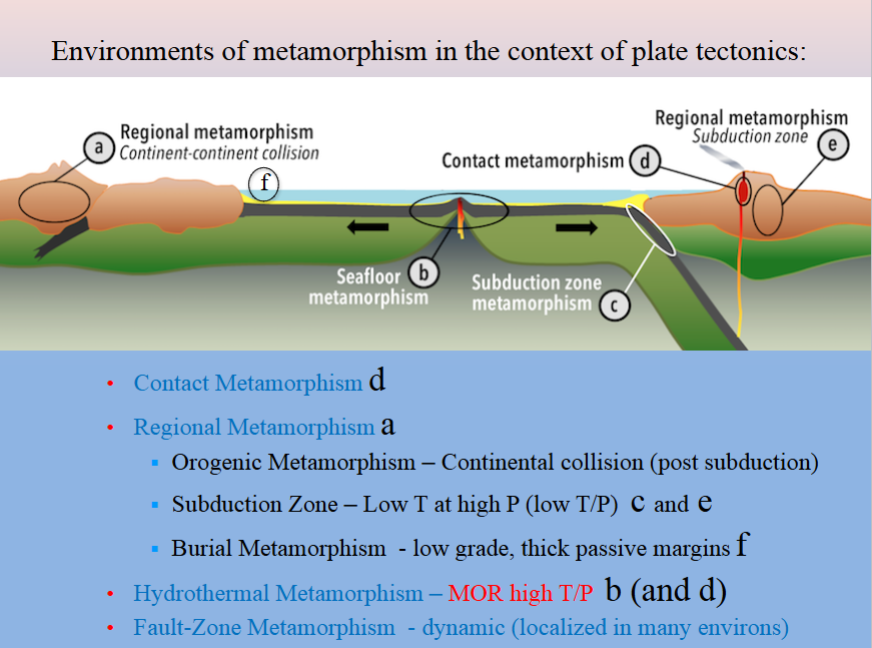
Contact Metamorphism: The size and shape of an aureole (metamorphoses zone around an intrusion) is controlled by:
The size and shape of an aureole (metamorphoses zone around an intrusion) is controlled by:
The nature of the pluton
Size
Shape
Orientation
Temperature
Composition
The nature of the country rocks
Composition
Depth and metamorphic grade prior to intrusion
Permeability
Contact Metamorphism: Most easily recognized where
Most easily recognized where a pluton is introduced into shallow rocks in a static environment causing recrystallize - typically surround epizonal plutons
→Hornfels (granofels) commonly with relict textures and structures of their protoliths
→ Non-foliated texture
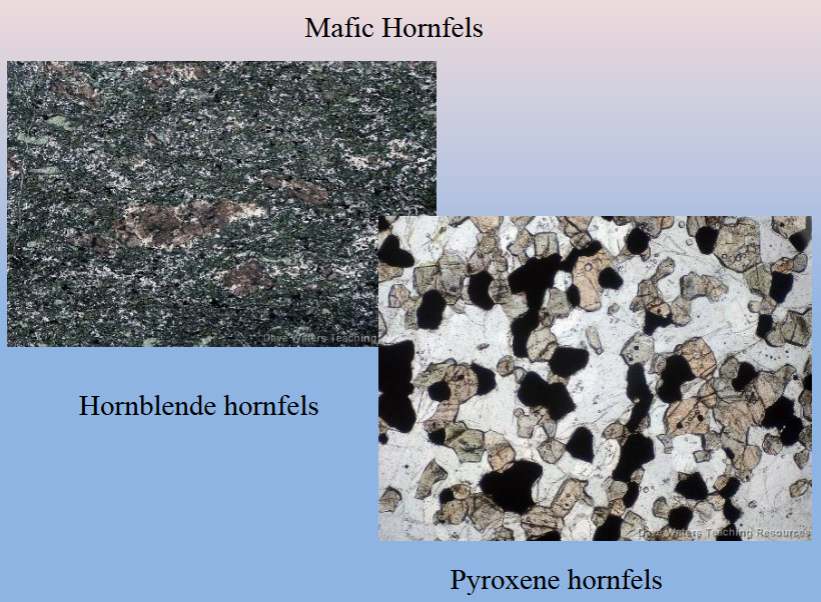
Contact Metamorphism
Plutonism is generally associated with contemporaneous orogeny, as with respect to the Andes
Polymetamorphic rocks are common, usually representing an orogenic event followed by a contact one
Spotted phyllite (or slate) - porphroblasts common
The foliated phyllite formed during a regional event and the later ovoid “spots” are minerals that grew during the contact event
Overprint may be due to:
Lag time for magma migration
a separate phase of post-orogenic collapse magmatism
The Types of Metamorphism: Pyrometamorphism
Pyrometamorphism:
Very high temperatures at low pressures, generated by a volcanic or sub-volcanic body; typically an M- or I-type: granitic rock
Form hornfels- granular, fine-grained textures; typically hornblende or pyroxene + plag
Also developed in xenoliths/enclaves of country rock enclosed in plutonic bodies
May be associated with magmatic assimilation
An example of contact metamorphism of Ordovician Skiddaw slates
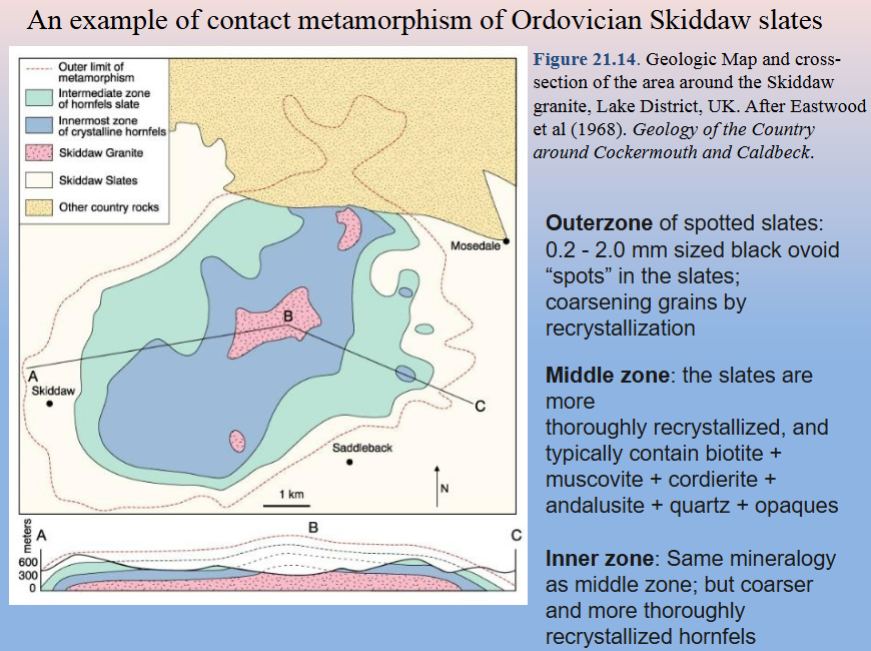
The Types of Metamorphism: Regional Metamorphism
Regional Metamorphism: metamorphism that affects a large body of rock, and this covers a great lateral extent
Three principal types:
Orogenic metamorphism
Includes Subduction Zone- paired metamorphic belts
Burial metamorphism
The Types of Metamorphism: Orogenic Metamorphism
Orogenic Metamorphism is the type of metamorphism associated with convergent plate margins
-Island arcs, active continental margins, and continental collision zones
-Most studies focus on orogenic belts, and the term, “regional metamorphism” is often used synonymously with “orogenic metamorphism”
Dynamo-thermal: one or more episodes of orogeny with combined elevated geothermal gradients and deformation (deviatoric stress)
Foliated rocks are a characteristic product
Regional metamorphism
Thickened crust creates more heat after subduction
Typical Catazonal S- and -I type granites.
Continental collision
Continental collision involves interaction of a continental arc with a continental mass having a “passive” margin and an apron of sediments extending from the continental shelf. Such collisions will usually produce even more complex structural magmatic and metamorphic patterns
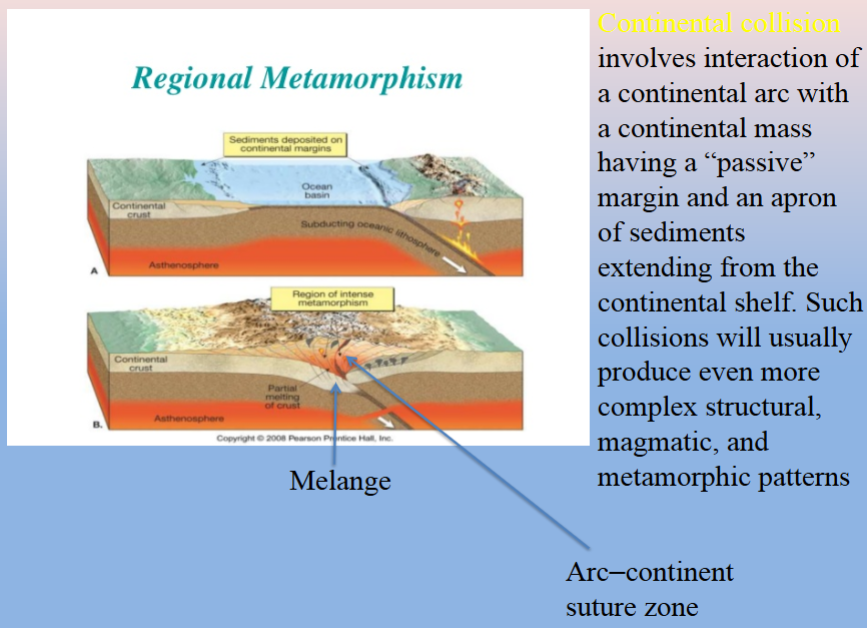
Schematic models for the uplift and extensional collapse of orogenically thickened continental crust
Subduction leads to thickened crust by either continental collision (a1) or compression of the continental arc (a2), each with its characteristic orogenic magmatism. Both mechanisms leaf to a thickened crust, and probably thickened mechanical and thermal boundary layers (“MBL” and “TBL”) as in (b)
Following the stable situation in (b), either compression ceases (c1) or th thick dense thermal boundary layer is removed by delamination or convective erosion (c2). The result is extension and collapse of the crust, thinning of the lithosphere, and rise of hot asthenosphere (d)
The increased heat flux in (d), plus the decompression melting of the rising asthenosphere, result in bimodal post-orogenic magmatism with both mafic mantle and silicic crustal melts
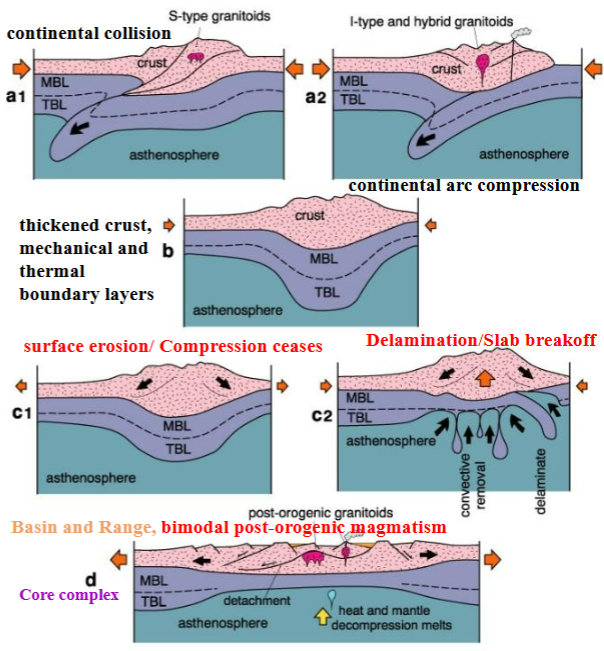
Orogenic Metamorphism
Uplift and erosion
Metamorphism often continues after major deformation ceases
Metamorphic pattern is simpler than the structural one
Pattern of increasing metamorphic grade from both directions toward the care area
Polymetamorphic patterns
continental collision- following subduction/arc volcanism (epizonal M-I type plutons)
Batholiths (catazonal S-I) are usually present in the highest grade areas (opposed to local contact metamorphism)
Possible to find paired metamorphic belts (Hi P/T close to Hi T/P)
Orogenic Regional Metamorphism of the Scottish Highlands
Barrow studied the peltic rocks
Could subdivide the area into a series of metamorphic zones, each based on the appearance of a new mineral (index mineral) as metamorphic grade increased
Barrovian zones
Chlorite zone. Pelitic rocks are slates and phyllites and typically contain chlorite, muscovite, quartz, and albite
Biotite zone: slate give way to phyllites and schists, with biotite, chlorite, muscovite, quartz, and albite
Garnet zone: schists with conspicuous red almandine garnet, usually with biotite, chlorite, muscovite, quartz, and albite or oligoclase
Staurolite zone: schists with staurolite , biotite, muscovite, quartz
Kyanite zone: schists with kyanite, biotite, muscovite, quartz, plagioclase, usually garnet and staurolite
Sillimanite zone: schists and gneisses with sillimanite, biotite, muscovite, quartz, plagioclase, garnet, and perhaps staurolite. Some kyanite may also be present (although kyanite and sillimate are both polymorphs of AL2SiO5)
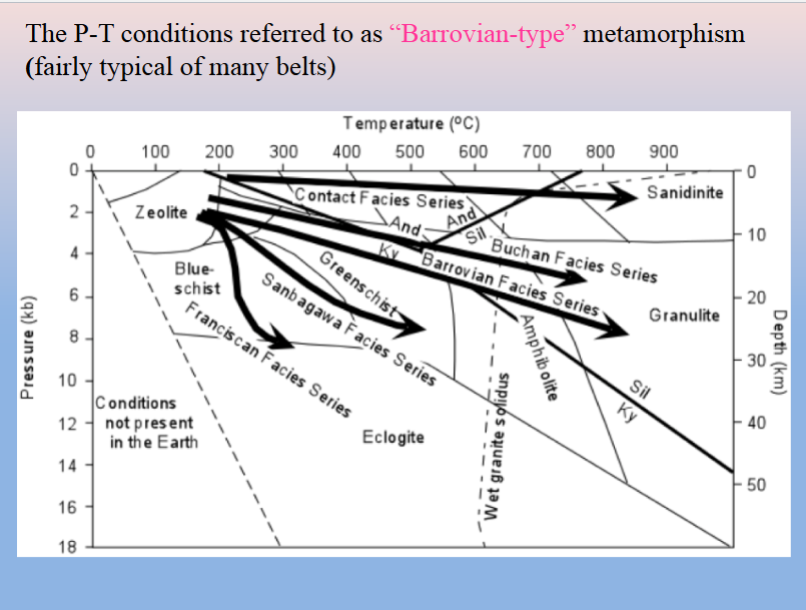
Sequence = “Barrovian zones”
now extended to a much larger area of the highlands
Isograd = line that separates the zones (a line in the field of constant metamorphic grade)
An isograd represents the first appearance of particular metamorphic index mineral in the field as one progresses up metamorphic
when one crosses an isograd, such as the biotite isograd, one enters the biotite zone
zone thus have the same name as the isograds that forms the low-grade boundary of that zone
because classic isograds are based on the first appearance of a mineral, and not its disappearance, an index mineral may still be stable in higher grade zones
A variation occurs in the area just to the north of Barrows, in the Banff and Buchan district
Pelitic composition are similar, but the sequence of isograds is:
chlorite
biotite
cordierite
andalusite
sillimanite
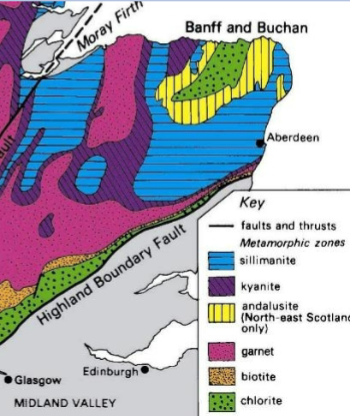
Buchan-type metamorphism
The geothermal gradient in this northern district was higher than in Barrow’s area, and rocks at any equivalent temperature must have been at a lower pressure This lower P/T variation has been called Buchan- type metamorphism. It too is relatively common
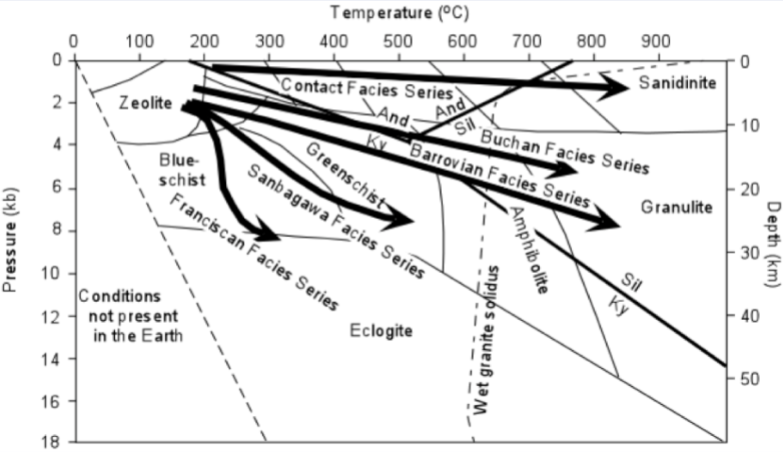
Aluminosilicate polymorph stabilities
The stability field of andalusite occurs at pressures less than 0.37 GPa (~ 10 km), while
kyanite → sillimanite at the sillimanite isograd only above this pressure
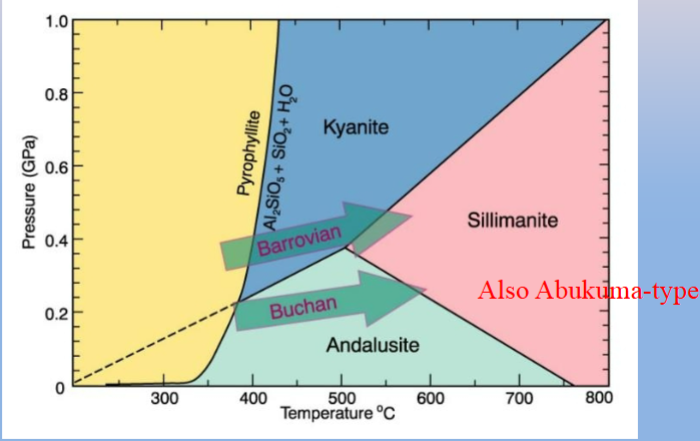
The Types of Metamorphism Burial metamorphism
low-grade metamorphism in sedimentary basins due to burial'
southland syncline in new zealand: thick pile (>10 km) of mesozoic volcaniclastics
mild deformation, no igneous intrusions discovered
fine-grained, high-temp phases, glassy ash: very susceptible to metamorphic alteration
metamorphic effects attrivuted to increased temperature and pressure due to burial (geotemal gradient)
diagenesis grades into the formation of zeolites, prehnites, pumpellynite, laumontite
The Types of Metamorphism Burial metamorphism
Burial metamorphism occurs in areas that have
not experienced significant deformation or orogeny
Restricted to large, relatively undisturbed
sedimentary piles away from active plate margins
The Gulf of Mexico: Modern example
Bengal Fan fed by the Ganges and Brahmaputra rivers
has the form of a sedimentary wedge accumulating
along a passive continental margin
Burial metamorphism
Burial metamorphism occurs in areas that have not experienced significant deformation or orogeny
• Bengal Fan → sedimentary pile > 22 km
• Extrapolating the low geothermal gradient at the surface
(18-22oC/km) → 250-300oC at the base (P ~ 0.6 GPa)
• Passive margins often become active as oceans close
• Areas of burial metamorphism may thus become areas of
orogenic metamorphism
• Regions where hydrocarbons are generated
• Methane seeps and low T vents common
Hydrothermal metamorphism (general type)
• Hot H2O-rich fluids (ground water or seawater)
• Usually involves metasomatism- chemically active fluids
• Difficult type to constrain: hydrothermal effects often play some role in most of the other types of metamorphism too
• Mineralized zones around plutons form this way
• Yellowstone is a good example
.
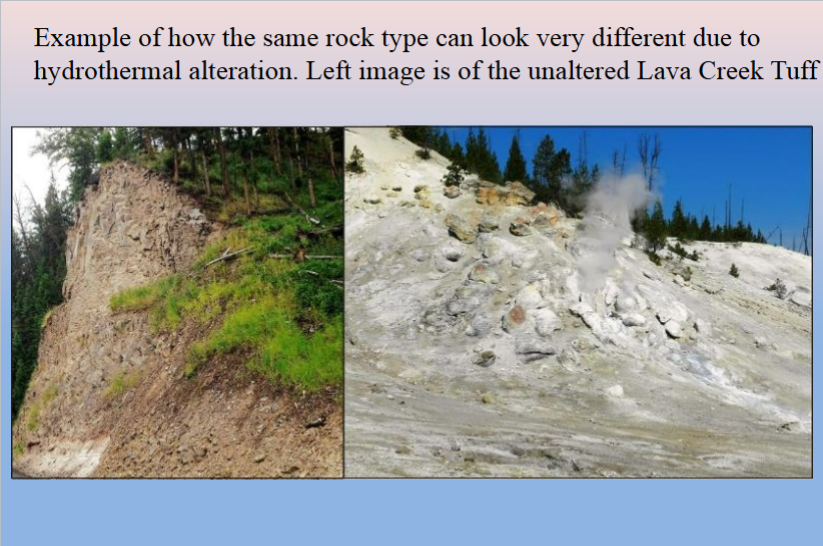
Ocean-Floor Metamorphism
Ocean-Floor Metamorphism affects the oceanic
crust at ocean ridge spreading centers (Hi T/Low P)
Another example of hydrothermal metamorphism
Seawater penetrates down ubiquitous fracture systems, where it becomes heated, and leaches metals and silica from the hot basalts
Chemical exchange between basalt, diabase and gabbro and hot seawater
Considerable metasomatic alteration, notably loss of Ca, Fe, Li, Zn, Cu, SO4 and Si and gain of Mg and Na (+ H2O, Cl,)
• Highly altered chlorite-quartz rocks-distinctive high-Mg, low-Ca composition (spillites form)
• Fluids are Fe- and Ca- rich (+ S, Cu, Zn, Mn) forming black smokers, Fe-sulfide chimneys and massive sulfide deposits.
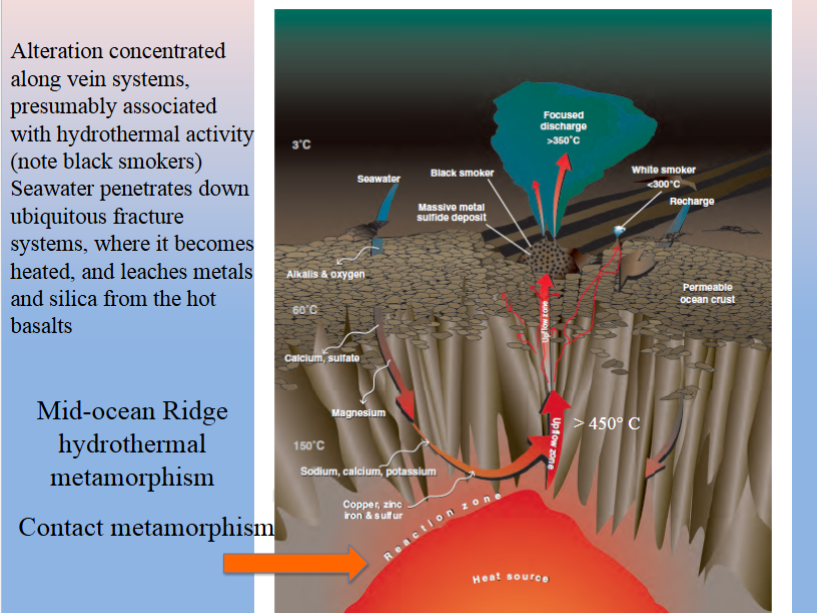
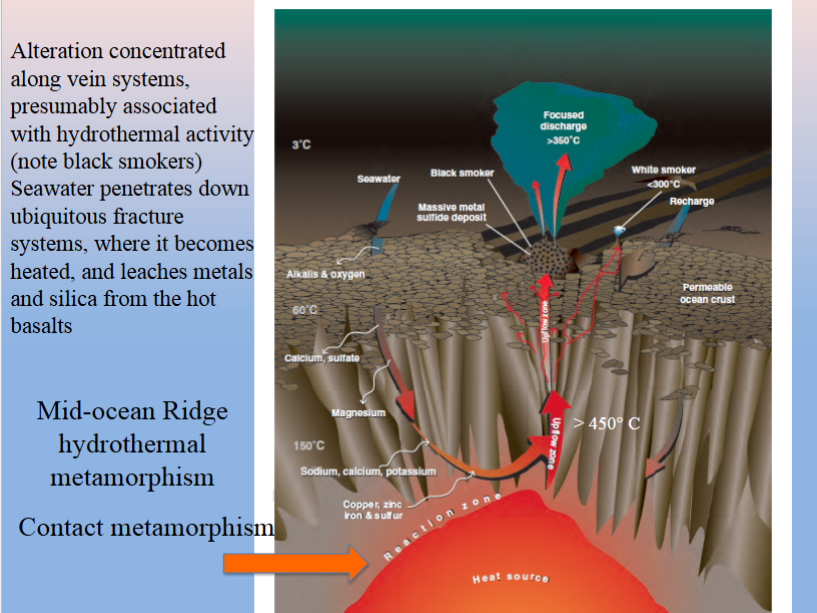

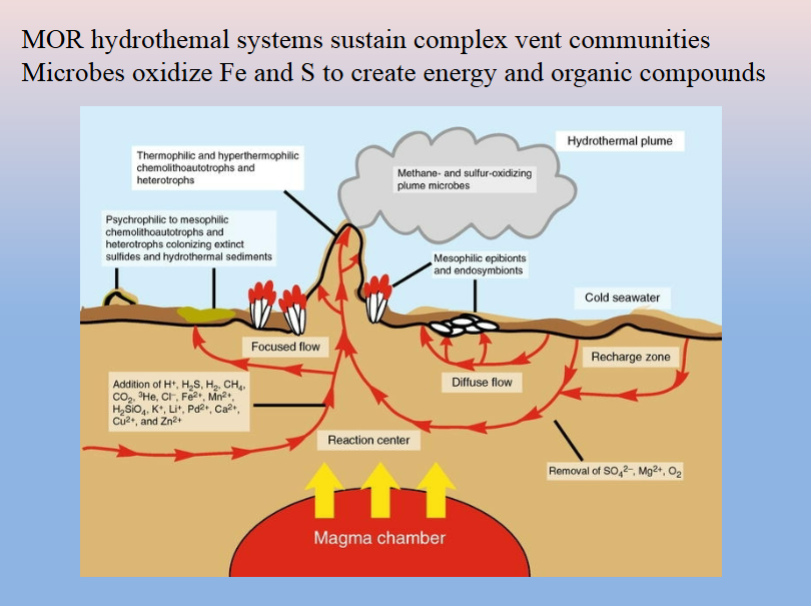
Ocean-Floor Metamorphism affects the oceanic
crust at ocean ridge spreading centers
Ocean-Floor Metamorphism affects the oceanic
crust at ocean ridge spreading centers
• Also low-T dynamic metamorphism at Oceanic Core
Complexes (OCC). Typical of Slow Spreading Centers
• Shear zones common – cataclastic deformation -
mylonite, serpentinite
• Hydration of peridotite = serpentine, brucite and talc
• Serpentinization and Carbonate Chimney
formation – Lost City on the Mid-Atlantic
The Types of Metamorphism
Fault-Zone (cataclastic) and Impact
“Fault” includes zones of distributed shear that can be up to several kilometers across
-High rates of deformation and strain with only
minor recrystallization (mylonitization)
-Mylonite is a metamorphic rock formed through intense ductile deformation, primarily in shear zones during folding and faulting
-Impact metamorphism at meteorite (or other bolide) impact craters
-Both correlate with dynamic metamorphism, based on process
Stages of Metamorphism
• Prograde: increase in metamorphic grade with time as a rock is subjected to gradually more severe conditions
Prograde metamorphism: changes in a rock that accompany increasing metamorphic grade
Involves dehydration reactions
• Retrograde: decreasing grade as rock cools and recovers from a metamorphic or igneous event
Retrograde metamorphism: any accompanying changes
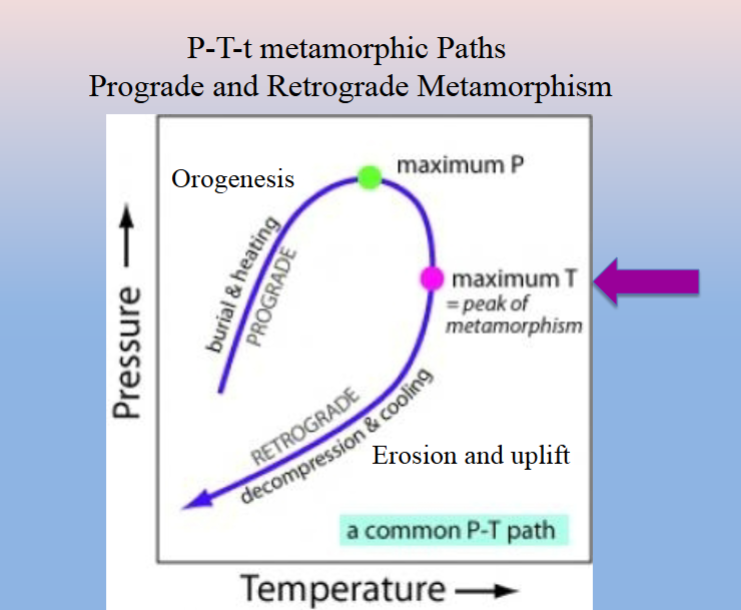
The Progressive Nature of Metamorphism
A rock at a high metamorphic grade probably progressed through a sequence of mineral assemblages rather than hopping directly from an unmetamorphosed rock to the metamorphic rock that we find today
Retrograde metamorphism typically of minor
significance
• Prograde reactions are endothermic and easily driven by increasing T
• Devolatilization/ dehydration reactions are easier than reintroducing the volatiles
• Geothermometry indicates that the mineral compositions commonly preserve the maximum temperature
Metamorphic Agents and Changes
• Metamorphic Agent:
• T (main agent); P (accompanies T increase); fluid High T/P paths (low P) favor the formation of low-density metamorphic minerals as temperature rises; Low T/P paths (high P) favor denser mineral
